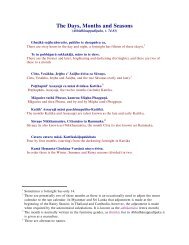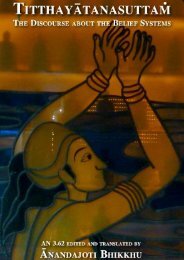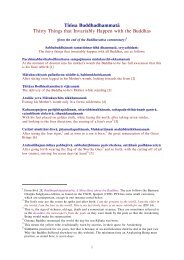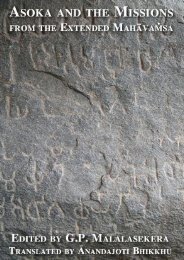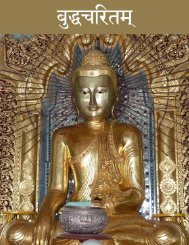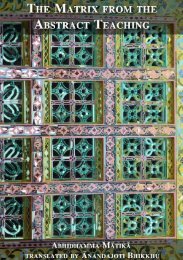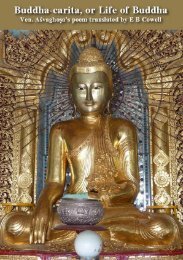The Sanskrit Text of Buddha-carita AÅvaghoá¹£a - buddhanet-de-index
The Sanskrit Text of Buddha-carita AÅvaghoá¹£a - buddhanet-de-index
The Sanskrit Text of Buddha-carita AÅvaghoá¹£a - buddhanet-de-index
- No tags were found...
Create successful ePaper yourself
Turn your PDF publications into a flip-book with our unique Google optimized e-Paper software.
Introduction to the <strong>Text</strong> - 7Indravajrā IIII 1 109Sālā IIUI 54Bālā IIIU 48Kīrti UIII 43Vāṇī IUII 41Mālā UUII 29Māyā IUUI 22Haṁsī UIUI 21Ārdrā UIIU 20Bhadrā IUIU 15Rāmā IIUU 15Chāyā UUUI 13UIUU 13Buddhi IUUU 11Premā UUIU 10Upendravajrā UUUU 10It is quite remarkable how the Indravajrā lines dominate in the Upajāti verses, withthe Indravajrā lines far in excess <strong>of</strong> any other, and the verses containing 3Indravajrā lines coming next. <strong>The</strong> Upendravajrā are significantly least inoccurrence.<strong>The</strong> breaks, which vary wi<strong>de</strong>ly in the earlier stages <strong>of</strong> Indian prosody are herealways found to be −⏑⏑, and similarly there is no significance attached to thecaesura, which may occur anywhere in the line.We can see from the sandhi that the pāda-s in the Upajāti lines were taken togetherfor pronounciation, which therefore differs from the early Pāḷi verses, where thepāda is the normal unit for purposes <strong>of</strong> pronunciation. 2Most <strong>of</strong> Chapters I, II, III, VII, IX, X, XI, and XIII are written in this metre.1 In the schemes given here I = Indravjrā lines, U = Upendravajrā lines. When there are 4Indravajrā lines in a verse, the whole verse is known by that name (similarly withUpendravajrā, <strong>of</strong> course).2 Similarly we may note that the syntax <strong>of</strong> the verses, which in the Pāḷi period was thepādayuga, is here the verse itself, sometimes extending to a group <strong>of</strong> verses.




